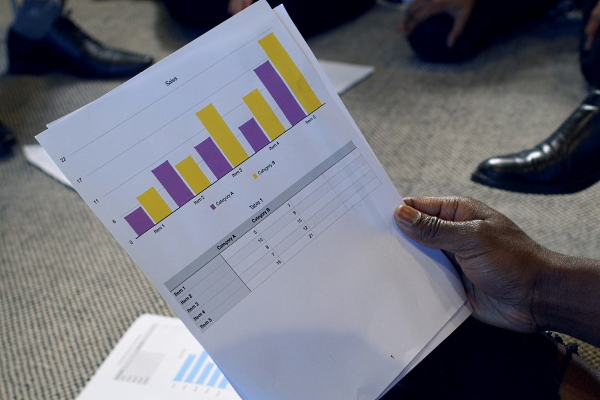To consider an application for financing, fill out the form and send it to us by e-mail along with the project brief, or contact our experts
This type of loans is used primarily for the implementation of large investment projects for the construction and modernization of fixed assets.
These borrowed funds can be used for the purchase of real estate, the construction of new and expansion of existing production lines, as well as the purchase of expensive machinery and equipment.
An important condition for obtaining a long-term bank loan is documentary evidence of the economic efficiency of the company, the availability of a well-prepared business plan and securing the loan with the borrower's assets.
In many cases, banks require the borrower to participate in the planned investment.
Depending on the type and scope of the project, the initial contribution of the initiator ranges from 10% to 20% of the project cost. The application of such a solution is based on the assumption that the borrower risking his own assets will be more interested in the success of the project.
The amount and terms of lending are selected individually, depending on the investment needs of the borrower.
The loan can be repaid according to a customized payment schedule adapted to the schedule of each project. The right choice of instruments for financing investment activities helps large companies around the world to grow their business, gaining a strategic advantage over competitors in an environment of risk and uncertainty.
In the context of the recovery of the world economy after the global crisis caused by the pandemic, it becomes important to improve lending, revive the role of lending in the formation of working capital and the implementation of investment projects.
Link Bridge Financial LTDA, a investment consulting company with an international presence, offers a wide range of financial services for large businesses, including long-term loans for 15-20 years. We provide funds for the implementation of investment projects in the field of energy, infrastructure, processing of minerals, industry, agriculture, environment, real estate and tourism.
Contact our team for details.
Long-term business lending: bank loan for 15-20 years
Investment lending has a positive impact on all areas of economic activity, contributing to the implementation of capital-intensive projects, the introduction of innovative technologies and the global energy transition.Experts say that the most important macroeconomic goals of long-term bank lending are the promotion of rationalization of production and sales, as well as obtaining maximum profit at the lowest possible cost.
In practice, the implementation of investment projects is accompanied by a number of difficulties, among which the greatest concern is the risk of non-payment of debt. An adequate assessment of the creditworthiness of the business, along with a rational structure of the loan agreement, helps to reduce this risk.
Risk factors of non-payment of bank loans include:
• The crisis of the world economy, which is expressed not only by a drop in production and poor financial health of companies, but also by the destruction of strong economic ties due to geopolitical tensions.
• Uneven economic development of regions, low production activity of enterprises and weakness of entire industries after a long and devastating pandemic.
• Weak support of credit activity in developing countries, inadequate legislation and an unsatisfactory state of the judicial system.
The combination of these factors determines the high cost of credit funds due to the high risk in long-term business lending. In this regard, the quality and safety of lending operations are becoming increasingly important.
Table: Stages of long-term business lending.
| Stage | Actions | Result |
| Preliminary stage | Finding out the reasons and purposes of obtaining a loan, as well as checking the sources of its repayment | Decision on consideration of the application, determination of the general parameters of the loan |
| Data collection and analysis of the applicant's credit history | ||
| Collection of financial information about the applicant's bank accounts and the movement of funds | ||
| Collection and analysis of data on the applicant's assets, including real estate and movable property of all types | ||
| Preparatory stage | Analysis of the statutory documents of the company | Quantification of the specific solution and clarification of the loan parameters |
| Detailed analysis of the financial statements of the borrower and evaluation of the provided business plan | ||
| Conducting a comprehensive marketing research to assess the practicality of implementing an investment project | ||
| Credit rating and business reputation analysis | ||
| Assessment of the value of collateral | ||
| Signing a loan agreement | Preparation of the general structure of the contract | Creation of a legal basis for the allocation of credit funds |
| Correction of the content of the loan agreement, taking into account the proposals of the interested parties | ||
| Loan agreement signing procedure | ||
| Issuance of credit funds | Formation of the borrower's credit dossier | Use of credit funds to support the investment activities of the company |
| Registration of a loan and transfer of credit funds by the operational department of the bank | ||
| Control over the use of credit | Professional monitoring of the company's activity and control over the implementation of the investment project | Investment loan repayment |
| Identification of signs of violation of the terms of the loan agreement (misuse of funds) | ||
| Implementation of a set of professional measures for dealing with problem loans. |
Successful lending requires a consensus between the lender and the borrower on each of the points of the agreement.

The loan agreement must meet the interests of both parties, and the entire lending process must be transparent and well thought out (distribution of responsibilities, establishment of responsibility). This requires a clearly structured credit policy that would determine the strategy of the financial institution's lending activities.
Credit policy of commercial banks
One of the ways to improve the business lending mechanism is to improve the issuance of loans in order to take into account the needs of customers and protect the bank from possible losses (taking into account the long repayment period of about 20 years or more).This policy covers each of the stages of the movement of credit funds:
• Allocation of a loan, which provides for the transfer of values by the lender for the purpose of their rational use and generating income.
• Purposeful use of the loan, which involves the direction of the funds received for the development of pre-agreed investment projects and the current activities of the company.
• Repayment of the loan using the proceeds from the project or mobilization of resources from other sources necessary for the return of borrowed funds.
The development of bank credit policy is especially important in the context of adaptation of financial institutions to the constantly changing conditions of the world economy.
The concept of the credit policy of a commercial bank, as a rule, consists of two parts.
The first part covers decision making on standard long-term loans, and the second part contains a list of procedures for doubtful or bad loans, as well as issues of credit risk management.
This policy should be consistent at all stages of the loan process, including consideration of an application for a long-term loan, an analytical assessment of the financial health of the company, making a decision on the allocation of funds, monitoring the correct use of the loan and repayment on time. The bank organizes appropriate measures to work with bad loans, selects options for debt restructuring, etc.
The credit policy of any bank should be based, first of all, on protecting the creditor's own interests and preventing the occurrence of risky cases of loan defaults.
The main directions of the organization of the credit policy of a commercial bank should be based on the following general principles:
• Optimization of interest rate policy and commissions.
• Classification of clients and the correct distribution of funds between them.
• Increased requirements for the quality and value of the collateral provided.
• Establishing a limit for a long-term investment loan.
Given the high competition in the banking sector, it is extremely important for lenders to consider the needs of their customers.
In practice, this boils down to a detailed study of the client's position, justification of raising borrowed funds for the implementation of each project, ensuring the availability of related banking services, and so on. The business lending program developed by the bank should meet the needs of the borrower as much as possible (loan amount, interest, repayment terms, conditions for the allocation of funds, collateral).
It is also important to ensure simplicity, transparency and clarity of loan registration procedures, adhering to uniform rules for refusal or approval of each loan application.
Currently, banks are striving to form the most profitable structure of the loan portfolio, which should provide for the diversification of allocated funds.
The general scheme for managing a loan portfolio of a commercial bank is the sequential implementation of the following works:
• Selection of criteria for assessing the quality of loans and segmentation of the loan portfolio.
• Accumulation of information to determine the risk of each group of borrowers.
• Rational classification and distribution of loans according to the degree of risk.
• Effective measures to manage bad loans.
In general, long-term bank lending to large businesses is a complex and multi-step process that must balance the lender's ability to make a profit with the risk of loss as a result of non-payment of debt.
Commercial banks today carefully evaluate each investment project, making an informed decision about granting a loan based on numerous risk factors.
Making a decision on issuing a large long-term loan
Banks make decisions based on a comprehensive assessment of the creditworthiness of the borrowing company, a detailed study of the business plan and a specific investment project, as well as an analysis of the market situation.This may require additional time and expense to carry out the related activities.
The main package of documents required by commercial banks to provide a long-term loan includes:
• Copies of the constituent documents of the company (charters, regulations, registration certificates, including documents confirming the authority of persons to conclude a loan agreement with a bank).
• Feasibility study of the project, indicating the payback period and sources of repayment of borrowed funds.
• Documents confirming ownership of property that can serve as collateral.
• Accounting reports and statistical data on the results of the company's activities, as well as materials of audits.
• A business plan for a starting company with no operating history.
• Data on loans received from other banks.
Banks may also require other documentation, which contains additional information about the peculiarities of the financial and economic activities of the borrower.
At this stage, the bank may have difficulties in verifying the accuracy of the information provided by the client, and the potential borrower has problems with collecting documentation, which is accompanied by additional material costs (for example, the assessment of the value of the collateral and its notarization).
The assessment of the customer's creditworthiness consists of internal and external diagnostics.
The development of an optimal algorithm for assessing creditworthiness should ensure an increase in the efficiency of the bank in providing credit for business activities by minimizing risks and improving the conditions for providing financing.

Table: Internal and external assessment of the borrower's creditworthiness
| Types of credit assessment procedures | Measures and their description | |
| Internal assessment | Preliminary measures | Identification of possible signs of the borrower's insolvency |
| Analysis of specific signs, identification of their causes and period | ||
| Analysis of the current financial health of a business company | ||
| Forecasting the financial potential of the company for the future | ||
| Assessment of potential problems with loan repayment | ||
| Main measures | In-depth search for possible signs of company insolvency | |
| Detailed analysis of the financial condition of the company | ||
| Study of any deviations in financial indicators | ||
| Comparative assessment of the creditworthiness of several borrowers | ||
| External assessment | Comprehensive analysis of the local and international long-term lending market | |
| Identification and assessment of various factors affecting risk | ||
| Classification and grouping of risk factors for the purpose of their comparative assessment | ||
| Determination of market development trends and their impact on risks | ||
| Analysis of possible losses of a financial institution in the future | ||
The results of assessing the creditworthiness of the borrower are considered by the bank in the context of the adopted credit risk management policy.
At the same time, the risk management policy should include bank liquidity management, loan portfolio liquidity management and credit risk management.
An important aspect is the material security of long-term investment loans.
Requirements for provision of collateral are a method of influencing the credit risk, which allows the bank, in the event of a loan default, to fully or partially compensate for the costs of lending operations. Banks' collateral requirements may include collateral (property rights, securities), guarantees, sureties, and so on.
In world practice, banks put forward rather stringent requirements for collateral:
• Possibility of quick sale of property.
• Stability of market prices for pledged items while maintaining consumer properties.
• The creditor's rights to own any property pledged.
• Ensuring the safe storage of pledged items within the specified period.
The subject of a pledge can be any property that the pledger has the right to alienate.
Anything that can be sold can be mortgaged.
This rule is based on the need to ensure the possibility, if the borrower fails to fulfill its obligations, to sell the pledged property and, at the expense of the funds received, to provide the bank with a debt repayment. The subject of a pledge can be property, which should become the property of the pledger after the conclusion of the contract.
It is important to conduct a correct assessment of the value of the collateral.
The value of the collateral is determined using various methods depending on the subject of the collateral (real estate, transport, finished products or goods), guided by the wholesale prices prevailing in the market.
When assessing the collateral, additional costs are taken into account that arise during the sale (for example, transportation costs, intermediary services of trading companies).
In the practice of commercial banks, common forms of securing the obligations of the borrower to the bank are a pledge of property, a guarantee or surety of a third party, assignment of the borrower's claims, liability insurance for non-payment of a loan and bankruptcy insurance.
A guarantee is a written commitment by a third party to repay a debt if the borrower refuses to pay.
For a bank, using a guarantee as a loan security instrument requires an assessment of the guarantor's risk as well as the borrower's risk.
A surety is an agreement with unilateral obligations, through which the guarantor undertakes an obligation to the lender to pay the borrower's debt, if necessary.
Surety agreements are regulated at the legislative level and are used with numerous restrictions and reservations, which is important to know before signing.

If you need detailed advice on business lending, please contact Link Bridge Financial LTDA.
We provide long-term loans for a period of 15-20 years or more for the implementation of capital-intensive projects.
Contact us now to learn more about the financing conditions.
The importance of long-term loans for the global economy
Effective management of commercial banks in the formation of the structure of the loan portfolio in order to increase the efficiency of loan investments is a decisive factor in the flow of funds into the real sector.The effectiveness of credit support for business entities directly depends on the ability of banks to manage their portfolio of their own assets and maintain financial stability, which ultimately affects the state of the entire world economy.
Bank lending to large businesses leads to the following positive effects:
• Increased business activity.
• Increased efficiency of production and commercial activities.
• Increasing the profitability of business entities.
• Increasing the volume of production of goods and services.
• Meeting public demand.
A positive moment in the orientation of the policy of commercial banks towards credit provision of business activity is the possibility of increasing the efficiency of the loan portfolio through diversification.
This approach is especially acceptable when lending to large businesses, given its high stability and relative reliability.
A long-term loan participates in the circulation of capital at all its stages, including the purchase of equipment, raw materials, energy and fuel, the construction of new production facilities, as well as the sale of goods and services on world markets. The main sources of loans are surplus funds generated by enterprises in the course of economic activity, as well as the money savings of the state and households mobilized by banks.
The key principles of lending are debt repayment, timeliness, targeting of borrowed funds, availability of debt collateral and a guarantee.
The objective need for long-term business lending arises in connection with the peculiarities of money circulation, production and marketing factors, differences in the timing of foreign economic operations, as well as the need for large investments to expand economic activities with insufficient borrower resources.
Regional and international financial institutions such as the World Bank, the European Bank for Reconstruction and Development (EBRD), the International Bank for Reconstruction and Development (IBRD), the Inter-American Development Bank and other reputable institutions play an important role in providing long-term large loans for business.
They provide active assistance in obtaining loans to companies from different countries, but primarily from developing countries.
International loans are of great importance for the development of the world economy:
• Improving the effectiveness of international relations.
• Growth and acceleration of national and global production.
• Maintaining continuous reproduction of material wealth.
• Creation of favorable conditions for foreign investments.
• Revitalization of the international division of labor.
• Strengthening the global financial system as a whole.
• Assistance in the creation and expansion of infrastructure.
• Promotion of international trade.
• Globalization of economic activity.
Long-term loans received by large companies from national and international financial institutions create favorable conditions for business development and help balance the global economy.
The global debt capital market creates additional demand for the acquisition of fixed capital by borrowing countries. Lacking sufficient internal resources, these players can buy the necessary equipment with an international loan.
Given the capital intensity and long term implementation of many infrastructure, industrial, energy and environmental projects, long-term lending for 15-20 years or more ensures the achievement of such goals as the transition to a carbon-free economy, the development of renewable energy sources, the solution of food crises, etc.
Perhaps the most important lending is in the construction of facilities such as factories, power plants, substations, roads and bridges, water treatment plants, mining and processing plants, mines and quarries. Our team is well aware of the practical aspects of the implementation of these projects, providing comprehensive qualified assistance to customers in Europe, USA, Latin America, North Africa, the Middle East and East Asia.
Link Bridge Financial LTDA offers large investment loans from 10 million euros and more for the implementation of long-term projects anywhere in the world.
We are also ready to provide a full range of financial services related to the organization of project financing (PF) and professional financial consulting at any stage of your business project.




























